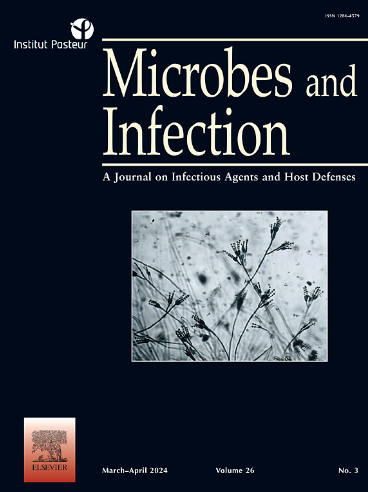甘油代谢抑制因子 GlpR 对猪链球菌抗氧化压力和病毒性有贡献
IF 2.7
4区 医学
Q3 IMMUNOLOGY
引用次数: 0
摘要
细菌 DeoR 家族转录调节器调控多种生理过程。人们对链球菌中 DeoR 家族调控因子的功能知之甚少。在这里,我们从猪链球菌(一种导致猪和人类严重疾病的病原体)中发现了一种新型 DeoR 家族调控因子 GlpR。GlpR 参与甘油的利用,并在第 30-31 位(KV)表现出特定的标志性残基,这些残基对 DNA 的结合至关重要。与野生型(WT)和互补株(CΔglpR)相比,缺失glpR(ΔglpR)会显著增加甘油培养基中的相对生长率。通过RNA-seq分析、β-半乳糖苷酶活性分析和电泳迁移分析,我们发现GlpR直接抑制了甘油代谢相关基因pflB2、pflA1和ffsaA的表达,这些基因分别编码丙酮酸醛酸酶及其激活酶和果糖-6-磷酸醛缩酶。与 WT 和 CΔglpR 相比,ΔglpR 在氧化应激和小鼠巨噬细胞中的存活率降低,对小鼠的毒力减弱。GlpR可能通过作为甘油代谢抑制因子降低能量消耗来增强猪链球菌的抗氧化应激能力和毒力。这些发现有助于更好地了解猪链球菌的致病机理,并丰富了我们对链球菌中 DeoR 家族调控因子生物学功能的认识。本文章由计算机程序翻译,如有差异,请以英文原文为准。
Glycerol metabolic repressor GlpR contributes to Streptococcus suis oxidative stress resistance and virulence
Bacterial DeoR family transcription regulators regulate multiple physiological processes. Little is known about the function of DeoR family regulators in streptococci. Here, we identified a novel DeoR family regulator, GlpR, from Streptococcus suis, a pathogen causing severe diseases in pigs and humans. GlpR was involved in glycerol utilization and exhibited specific signature residues at positions 30–31 (KV) which are crucial for DNA binding. Deletion of glpR (ΔglpR) showed a significant increase in relative growth rate in glycerol medium compared to the wild-type (WT) and complementary strains (CΔglpR). Employing RNA-seq analysis, β-galactosidase activity analysis, and electrophoretic mobility shift assay, we discovered that GlpR directly represses the expression of glycerol metabolism-related genes pflB2, pflA1, and fsaA, encoding pyruvate formate-lyase and its activating enzyme, and fructose-6-phosphate aldolase, respectively. Compared to WT and CΔglpR, ΔglpR showed a reduced survival rate under oxidative stress and in murine macrophages and attenuated virulence in mice. GlpR probably enhances oxidative stress resistance and virulence in S. suis by functioning as a glycerol metabolic repressor decreasing energy consumption. These findings contribute to a better understanding of S. suis pathogenesis and enrich our knowledge of the biological functions of DeoR family regulators in streptococci.
求助全文
通过发布文献求助,成功后即可免费获取论文全文。
去求助
来源期刊

Microbes and Infection
医学-病毒学
CiteScore
12.60
自引率
1.70%
发文量
90
审稿时长
40 days
期刊介绍:
Microbes and Infection publishes 10 peer-reviewed issues per year in all fields of infection and immunity, covering the different levels of host-microbe interactions, and in particular:
the molecular biology and cell biology of the crosstalk between hosts (human and model organisms) and microbes (viruses, bacteria, parasites and fungi), including molecular virulence and evasion mechanisms.
the immune response to infection, including pathogenesis and host susceptibility.
emerging human infectious diseases.
systems immunology.
molecular epidemiology/genetics of host pathogen interactions.
microbiota and host "interactions".
vaccine development, including novel strategies and adjuvants.
Clinical studies, accounts of clinical trials and biomarker studies in infectious diseases are within the scope of the journal.
Microbes and Infection publishes articles on human pathogens or pathogens of model systems. However, articles on other microbes can be published if they contribute to our understanding of basic mechanisms of host-pathogen interactions. Purely descriptive and preliminary studies are discouraged.
 求助内容:
求助内容: 应助结果提醒方式:
应助结果提醒方式:


